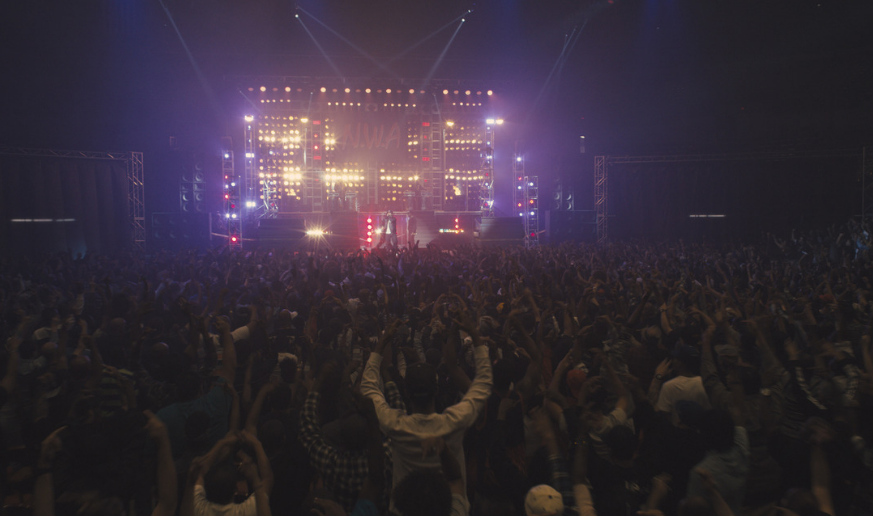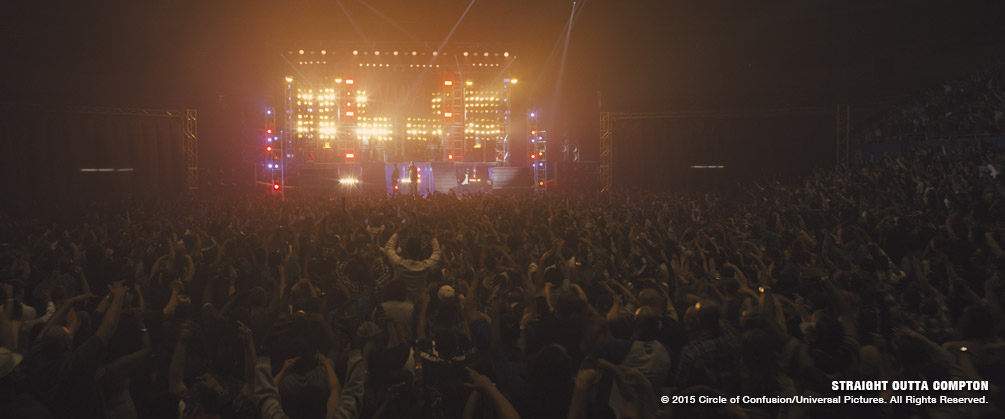Straight Outta Compton Case Study

Case Study
Straight Outta Compton may not feature sentient robots, refugee aliens or fiercely intelligent velociraptors, but when you’re the lead vendor working across an entire project there’s always going to be an element of challenge. Read on to discover how Image Engine reimagined the 80s for N.W.A.’s hugely successful blockbuster biopic.
Straight Outta Compton stands as something of an anomaly – an R-rated biopic released in the heat of superhero season that nevertheless recouped $56.1 million in its opening weekend. It’s a level of success that flies in the face of accepted tradition; one born from a perfect storm of musical ability and contentious subject matter that resonates even today.
F. Gary Gray’s film may not be about superheroes, but it is an origin story of sorts, detailing the trials and tribulations of notorious rap group N.W.A., who burst onto the mid-80s LA scene with an incendiary – and somewhat controversial – energy. They couldn’t fly or set themselves alight, but they had a superpower of another sort: the ability to turn urban despair into lyrical poetry, inciting the ire of the establishment as they did so.
And while the film didn’t require a plethora of high-end visual effects to bring its characters to life, it did require a range of subtly implemented tweaks in order to sell its 80s LA setting. That’s where Image Engine came in – the lead vendor responsible for all CG work across the production, with Lola VFX in Los Angeles providing additional cleanup work.
It was a significant amount of work for Image Engine, with visual effects supervisor Bernhard Kimbacher taking point and bringing his past experience on similarly low-key visual effects projects Child 44 and Lone Survivor to the fore. For Image Engine, the level of dedication to a project remains consistent no matter the input required: “As a studio we’ve always prided ourselves on being able to work across all budget levels while maintaining a keen eye to quality of execution,” says visual effects executive producer Shawn Walsh.
For Kimbacher, having worked on projects of a similar scope in the past, Straight Outta Compton felt like a natural progression. “It’s a 2D heavy show – mostly comp and matte painting based, with some 3D elements here and there,” he explains. “Compared to the larger shows Image Engine has worked on, it’s bread and butter work. Nevertheless, it takes skill to incorporate this brand of invisible visual effects into a realistic world. If the audience notices something is off, or doesn’t look quite like it should, then they’re going to be pulled out of the immersive experience. In a film where authenticity is key, you have to make sure you’re delivering those visuals very, very carefully.”
And authenticity really was a big concern, with original N.W.A. members Dr. Dre and Ice Cube taking on the role of producers, ensuring the film’s content aligned with their own past experiences.
“I personally didn’t know much about the subject matter going in,” admits Kimbacher. “However, getting involved with the people that grew up in these environments and had a passion for them was really interesting. The director was heavily involved with N.W.A. from way back, so along with Ice Cube and Dr. Dre they wanted to ensure that everything was as accurate as could be. They would be with us on the shoots in the streets of LA, pointing out buildings that weren’t supposed to be there or certain elements that didn’t fit in with their past. It was a great experience, and one that – with the assistance of visual effects – helped root the film in reality.”
Period detail
Responsibility for recreating elements of this bygone LA rested on the shoulders of Image Engine – and Dr. Dre and Ice Cube do not make for an easy crowd to please. Image Engine launched into the project with gusto, adding, enhancing or removing details wherever necessary.
“The work ranged from smaller stuff, like painting out contemporary signs, to much larger jobs like the addition of buildings,” explains Kimbacher. “For instance, there’s one scene in which Eazy-E drives down Sunset Blvd. There’s a section of the strip where Towers Records once stood, so we needed to add that into the scene. That was one of the biggest period fix jobs, and it was all done in 2.5D, with the matte paintings projected onto geometry.”
These period fixes also extended to the roads of 80s LA, where the most recent Audi or Mitsubishi hybrid would look suspiciously out of place. “In the scenes where the group is driving around LA in a car, we would have to paint out newer buildings and cars on the sidewalk,” says Kimbacher. “In some cases, we found it easier to build 3D period cars, like Oldsmobiles. We could then just drop those CG cars on top of the real cars in the background.”
Of course, research was required to make sure that these replacements and fixes were true to the real 80s setting. “I wasn’t living in LA in the 80s, so we had someone to help out with that,” explains Kimbacher. “For a few shots, they had someone from LA take in the scene and assess what needed to be done. It was then up to us to remove those elements or find suitable replacements for anything that gave away the fact that we were actually shooting in modern-day Los Angeles.”

I predict a riot
From the architecture and roads to the history of the city itself, Kimbacher and his team needed to ensure that any moments relived from the past felt as authentic as the city they were occurring in. That meant enhancing on-set effects occurring during reenactments of the 1992 Los Angeles riots.
“They did an amazing job of dressing the set during the shoot,” remembers Kimbacher. “They had three blocks of destroyed LA to work with, which was a great starting point for the visual effects team! In the end, there were just three or four shots that we needed to add elements to, such as extra smoke to give more punch to the events occurring, or to cover up equipment that shouldn’t be seen in the shot. Overall we were just making sure the scene didn’t look too clean, and that it communicated the kind of chaos that would have been felt by anyone who experienced the actual riots.”
And from one kind of riot to another altogether, Image Engine was also required to extend and enhance the crowds of fans attending N.W.A.’s cathartic live performances. While the production did have access to 2,000 enthusiastic extras, it was the subtle implementation of visual effects that really added impact to the scene.
“For the crowd extensions we took a completely 2D approach,” says Kimbacher. “The 2,000 volunteer extras were unusually high for a movie, which was great. However, we needed to add much more impact. So, over a 3-hour period we went through all of the songs N.W.A. performs in the stadium with the different lighting setups. We got the whole crowd to listen and move to the songs in all of the different parts of the location. As we had ensured we had the right lighting for each scene, we could then place the whole crowd together easily in comp, matching the right part of the song to each of the plates. In the end, we went from a crowd of 2,000 N.W.A. fans to an army of 20,000.”
It’s all in the details
From hordes of fans and the addition of bygone buildings to much more subtle work, Straight Outta Compton is also full of the kind of low-key tweaks and touches that cement a film in reality. They may not represent the glitz and glamour the visual effects industry is known for, but they’re no less important.
“We did a lot of things like monitor replacements, which is very straightforward stuff but also very necessary,” says Kimbacher. “For instance, the props that they were using for the TVs were so old that they actually didn’t work – also, the director didn’t know at the point of shooting what he actually wanted on the monitors – so we needed to put those screens in during post. We ended up putting in images like 80s TV shows, N.W.A. music videos, and, in one scene on the tour bus, some content of a more unsavoury kind! It was pretty easy for us to do, but it gives the director that extra freedom when it comes to making changes later down the line.”
The tour bus scenes were shot on a green screen set, leaving it up to Image Engine to create the rolling green expanses of the American midwest outside the bus windows. “Shooting-wise, this was a very simple green screen set-up,” says Kimbacher. “However, we ran out of time during the main shoot of the plates. As a temporary backup for director screenings, we went out into Vancouver where the landscape is pretty flat and shot some background plates ourselves. The shots ended up working so well that the production asked us to use our plates for the final version. It worked really well and saved the production a bunch of money.”
Straight outta Image Engine
Straight Outta Compton may not have required full-CG creatures or a plethora of explosive set pieces, but it nevertheless demanded the level of care and quality in its visual effects that Image Engine has come to be known for. As the lead vendor, Image Engine, along with some help from Lola VFX, was prepared to deliver.
“On this particular show, it was more the nature of the show rather than the technical features of its visual effects that stands out as being different,” explains Kimbacher. “Rarely do you work so closely with a production where the people are involved on such a personal level. It’s not somebody telling someone else’s story – it’s N.W.A. telling their own story. Being involved with that so closely was definitely very special. Coming in as an outsider – and as a European in my case – it was really interesting to enter that world and see how much it all meant to them. The visual effects really had to stand up to that level of passion and dedication to the subject matter.”
And for Kimbacher the experience was almost just as personal, the production testing his ability beyond the usual application of visual effects knowledge.
“I was the only visual effects supervisor on this project, so that was a first for me,” he says of the experience. “I saw production through from the beginning to the end, including involvement in pre-production and some of the shoot itself, so there was a big learning curve there.
“Visual effects-wise we weren’t reinventing the wheel; it was all stuff that we know we can do, and do well. What was different was working with people passionate about the subject matter and executing the required visuals in a streamlined and efficient way. I believe that we achieved that with skill, and it shows – or doesn’t, as the case should be – in the production’s invisible visual effects.”

